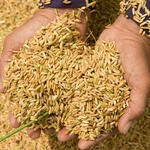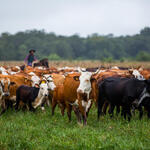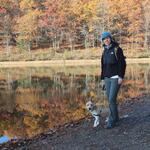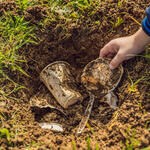- Date: 15 April 2022
- Author: Ayse Koçak, TikTok
At TikTok, our mission is to inspire creativity and bring joy. We're proud that over 1 billion people come to our platform each month in search of entertainment and an outlet to share what matters to them. We know that this would not be possible without our community's trust in our ability to maintain a safe and welcoming environment. We believe that everyone should be able to express themselves creatively and be entertained, but not at the expense of other forms of life.
Last year, TikTok joined the Coalition to End Wildlife Trafficking Online, which was established in 2018 by World Wildlife Fund (WWF), TRAFFIC, and IFAW to bring together e-commerce, search, and social platforms across the world to reduce wildlife trafficking online. Since then, we've worked closely with WWF to enhance our policies, launch in-app safety features and tools, and encourage education around the life forms with which we share a planet. In doing so, we aim to continue our work to prevent harmful content and behavior, including wildlife trafficking, from proliferating on the platform.
- Date: 14 April 2022
In our Behind the Scenes series we speak to WWF staff to learn more about their work and what makes them tick. For today’s post, we caught up with Afsoon Namini, a director with WWF's Private Sector Engagement Team.
- Date: 13 April 2022
- Author: Julia Kurnik and Katherine Devine, World Wildlife Fund
Most agricultural methane emissions (around 70%) come from ruminants, such as cows and sheep. This is primarily due to manure and gastroenteric releases—or, simply put, cow burps. Most methane for cattle, particularly beef, is released in the grazing phase of the supply chain. When cattle roam for grazing, it is difficult to track methane release or to mitigate emissions due to the nature of grazing. Furthermore, scalability and traceability are challenging, particularly for small-scale grazing operations.
- Date: 13 April 2022
- Author: Tara Doyle, World Wildlife Fund

Jennifer Green, Sustainability Director for the City of Burlington.
In this blog series, I’m speaking with sustainability officials in local governments around the country to learn about how they’re tackling socio-environmental issues within the public sector. This week, I had the opportunity to hear from Jennifer Green about her work on one of the boldest, most innovative climate action plans in the nation.
Jennifer Green is the Sustainability Director for the City of Burlington, Vermont. Green previously worked on international issues at the World Resources Institute (WRI) but shifted to a domestic focus upon moving to Burlington with her family. Shortly after moving to Vermont, she worked at the City’s Community and Economic Development Office. After Burlington announced its plan to transition to 100 percent renewable energy, Green’s position was moved to the Burlington Electric Department (BED) to maximize the impact of her work in supporting Net Zero Energy efforts. Describing her favorite aspects of her job, Green says, “It’s such a privilege to work for the city in which you live. The partnerships between the business sector, the nonprofit sector, and the residents of Burlington are really exciting to me. And when you’re a government official, you get to actualize ideas in the form of policy.”
- Date: 12 April 2022
- Author: By Julia Kurnik and Katherine Devine, World Wildlife Fund
Rice, one of the most abundant crops grown and consumed globally, makes up 12% of global methane emissions – and a staggering 1.5% of total greenhouse gas emissions. When rice is harvested, a ton of rice stubble and straw is left behind for every ton of harvested rice – 750 million tons globally in 2015. Currently, to clear fields for future crops, farmers either burn the rice straw, which results in significant carbon dioxide emissions as well as methane, carbon monoxide, nitrogen oxides, sulfur oxides, and particulate matters, or they flood the field to encourage swift decay – which also leads to extensive methane emissions.
- Date: 11 April 2022
- Author: Julia Kurnik and Katherine Devine, World Wildlife Fund
Global leaders in Glasgow recently signed the Global Methane Pledge and recognized that addressing methane emissions is imperative if we’re going to achieve a 1.5° C future. In fact, the IPCC calculates that methane emissions will need to drop 37% below 2017 levels by 2030 and 55% below 2017 levels by 2050 to keep that goal within range. At COP 26, President Biden announced the US will join a global coalition of more than 100 countries pledging to cut global methane levels by a minimum of 30% by 2030 and rolled out an action plan for US methane emissions reductions.
- Date: 11 April 2022
In our Behind the Scenes series we speak to WWF staff to learn more about their work and what makes them tick. For today’s post, we sat down with Mary Jo Snavely, a manager with WWF's Private Sector Engagement Team.
- Date: 08 April 2022
Biodegradable and compostable plastic is becoming a more frequent option on store shelves as the demand for “green” products grows. Given the fact that a dump truck’s worth of plastic waste enters our oceans each minute, it’s not surprising that people are looking to use their purchasing power in ways that will presumably leave a smaller footprint.
The growing trend in plastic use is fueled by the assumption that if a product or its packaging is labeled as “biodegradable” or “compostable,” then it must be the more sustainable option. Unfortunately, that is not necessarily the case.
As the production of biodegradable plastics jumps from 1.5M metric tons to almost 5.3M in the coming years, understanding exactly how these materials are helping—or hurting—the environment is critical.
Let’s break down some of the common questions that can help clarify what biodegradable and compostable plastic mean for the environment:
- Date: 07 April 2022
In our Behind the Scenes series we speak to WWF staff to learn more about their work and what makes them tick. For today’s post, we had the pleasure of catching up with Akiva Fishman, WWF's Manager of Private Sector Interventions to Tackle Deforestation and Forest Degradation.

There’s No Climate Action Without Community Outreach: A Conversation with San Diego’s Moriah Saldaña
- Date: 06 April 2022
- Author: Tara Doyle, World Wildlife Fund

Moriah Saldaña, the Climate Action Plan Program Manager for the City of San Diego’s Sustainability and Mobility Department.
In this blog series, I’m speaking with sustainability officials in local governments around the country to learn about how they’re tackling socio-environmental issues within the public sector. This week, I interviewed Moriah Saldaña, the Climate Action Plan Program Manager for the City of San Diego’s Sustainability and Mobility Department. Moriah grew up in San Bernardino, a region with historically poor air quality that likely contributed to her asthma and inspired her to become an environmentalist from an early age.
After earning her Master’s in Public Administration from San Diego State University, Saldaña joined the environmental nonprofit I Love A Clean San Diego (ILACSD), where she organized large-scale volunteer events to collect litter and debris from the beach. Saldaña started at ILACSD as a part-time program assistant and became their Director of Regional Affairs after five years. In that position, she managed government contracts and ran zero-waste educational programs in local schools, all while gaining public sector connections that later helped her transition into the San Diego government.
In 2015, the City adopted a Climate Action Plan that aims to cut greenhouse gas emissions by 50% and obtain 100% of its energy from renewable sources by 2035. The plan outlines five major goal areas: building utilities, renewable energy, transportation/land allocation, waste elimination, and climate adaptation. I spoke to Moriah about the Climate Action Plan, why she loves working in the public sector, and more.








